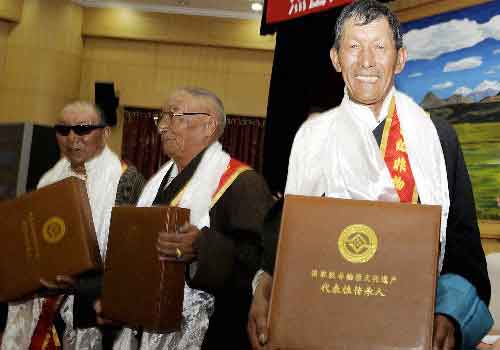Folk cultural industry helps Qinghai Tibetan-inhabited area shake off poverty
After the Spring Festival, Sha Wujiao, a clay sculptor from Qinghai’s Huangnan Tibetan Autonomous Prefecture, took his high school son to the studio to show him how to make fine clay sculptures.
Sha Wujiao was confirmed as an inheritor of the national intangible cultural heritage - a Regong art of the Huangnan Tibetan Autonomous Prefecture in 2009. When he was younger, he never even thought about turning a culture into an industry.
With support from the local government, Sha Wujiao built up an art academy and recruited students. He believes that this will not only pass down the traditional cultural heritage, but also provide the local people with a new path to shaking off poverty.
“Our income from clay sculpting is now pretty good,” Sha Wujiao said. “We used to make clay sculptures mainly for Buddha statues in temples, but now we can also make decorations for Tibetan-style houses and urban sculptures.”
He said that there was barely anyone to come to learn in the past, but in recent years more and more people have signed up, with 60 percent of the students coming from poor families. In the first year it is free; in the second year they begin receiving salaries; and after the third and fourth year their families no longer bear any economic burden. Today the art academy has developed from only a few to hundreds of students.
In 2015, over 100 Regong cultural enterprises have been set up in Huangnan, and more than 20,000 people are engaged in culture-related industries across the prefecture with the annual output of over 450 million yuan.
Lhalung Tamdrin, deputy director of Huangnan Prefecture Cultural, Radio and Television Bureau, said that the current market and traditional culture are not integrated, so the Regong culture and the market must be linked up in the next five years.
Your Comment
Name E-mailRelated News
-
;
-
-

-
Cultural protection promoted by Tibet regional political advisors
Over 500 members of the CPPCC Tibet Committee submitted a total of 495 proposals in 2015, including 110 ones on culture, a hot topic of the members.
-
-
-

-
Tibet to record skills of senior intangible culture inheritors
The Tibet Autonomous Region recently began to launch the recording of the artistic skills of 10 national-level elderly intangible culture inheritors.
-
Based in Lhasa, Tibet Vista is a Tibet travel agency that specialized in Tibet permit, and Tibet tours for both private and group travelers at a local price!
•4 Days Lhasa City Group Tour from USD 460 •8 Days Everest Base Camp Group Tour from USD 850 •15 Days Mt.Kailash Group Tour from USD 1780 •2016 Tibet Train Tours from Beijing, Shanghai, Chengdu, Xining,etc










